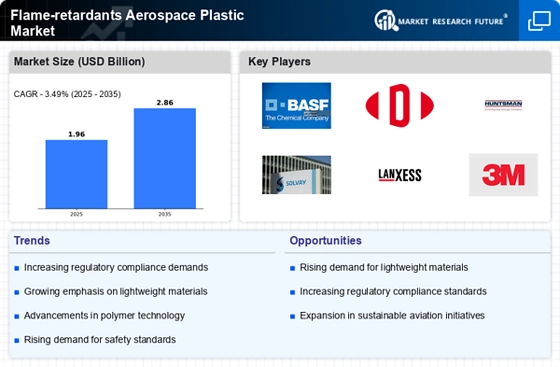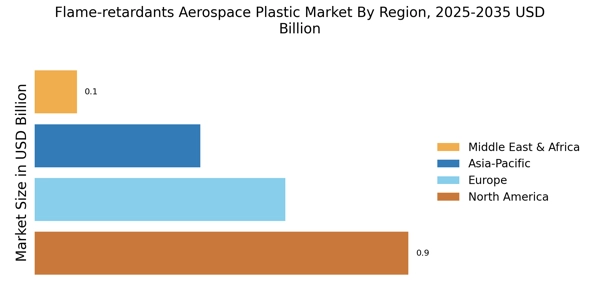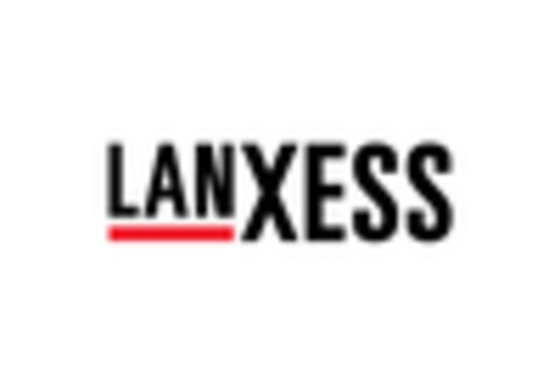Increased Focus on Passenger Safety
An increased focus on passenger safety is a vital driver for the Flame-retardants Aerospace Plastic Market. Airlines and manufacturers are under constant pressure to enhance safety measures, particularly concerning fire hazards. The tragic incidents in aviation history have led to heightened awareness and stricter regulations regarding the materials used in aircraft interiors. Consequently, there is a growing emphasis on incorporating flame-retardant plastics in various applications, such as seating, cabin linings, and cargo areas. This focus on safety not only drives demand for compliant materials but also encourages innovation in flame-retardant technologies. As the industry continues to prioritize passenger safety, the market for flame-retardants is likely to experience sustained growth.
Growing Demand for Lightweight Materials
The growing demand for lightweight materials in the aerospace sector is a crucial driver for the Flame-retardants Aerospace Plastic Market. As airlines and manufacturers strive to improve fuel efficiency and reduce emissions, the need for lighter materials has become paramount. Flame-retardant plastics offer an ideal solution, as they can significantly reduce weight without compromising safety. According to industry reports, the aerospace sector is increasingly adopting composite materials, which often require flame-retardant properties to meet safety standards. This trend is expected to continue, with the market for flame-retardants in aerospace plastics projected to expand as manufacturers seek to balance performance, safety, and environmental considerations.
Sustainability and Eco-friendly Practices
Sustainability and eco-friendly practices are increasingly shaping the Flame-retardants Aerospace Plastic Market. As environmental concerns gain prominence, manufacturers are exploring sustainable alternatives to traditional flame-retardants. The push for greener materials is prompting the development of bio-based flame-retardants that meet safety standards while minimizing environmental impact. This shift aligns with the aerospace industry's broader commitment to reducing its carbon footprint. Furthermore, regulatory bodies are beginning to favor eco-friendly materials, which could influence market dynamics. The integration of sustainability into product development is expected to drive innovation and create new opportunities within the flame-retardants aerospace plastic sector, potentially leading to a more sustainable future.
Regulatory Compliance and Safety Standards
The Flame-retardants Aerospace Plastic Market is significantly influenced by stringent regulatory compliance and safety standards. Governments and aviation authorities impose rigorous regulations to ensure the safety of aircraft materials, particularly in terms of fire resistance. This has led to an increased demand for flame-retardant plastics that meet these standards. For instance, the Federal Aviation Administration (FAA) mandates specific flammability tests for materials used in aircraft interiors. As a result, manufacturers are compelled to innovate and develop advanced flame-retardant materials that not only comply with regulations but also enhance overall safety. The market is projected to grow as more companies prioritize compliance, leading to a surge in the adoption of flame-retardants in aerospace applications.
Technological Advancements in Material Science
Technological advancements in material science are driving the Flame-retardants Aerospace Plastic Market forward. Innovations in polymer chemistry and material engineering have led to the development of new flame-retardant additives that improve the performance of aerospace plastics. These advancements enable manufacturers to create lighter, stronger, and more heat-resistant materials, which are essential for modern aircraft design. The integration of nanotechnology and smart materials is also emerging, potentially revolutionizing the industry. As aerospace manufacturers seek to enhance fuel efficiency and reduce weight, the demand for advanced flame-retardants is likely to increase, thereby propelling market growth. The ongoing research and development efforts in this field suggest a promising future for flame-retardants in aerospace applications.


















Leave a Comment